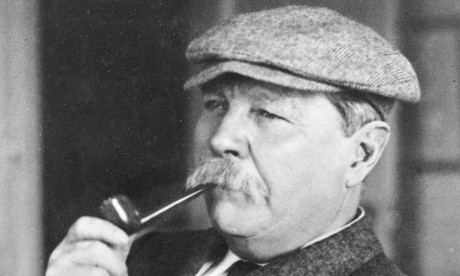Science Seen Physicist and Time One author Colin Gillespie helps you understand your world.
Eye on Doyle
 Arthur (latterly Sir Arthur) Conan Doyle, a practising physician, surgeon and ophthalmologist is well known for his fictional detective, Sherlock Holmes. I, too, am a fan. Doyle is less known for the sharp eye that he kept on physics. It shows up in the way his fiction promotes then-new physics-based ideas. Through the 1900s these ideas transform the detection of real crime and build a foundation for CSI.
Arthur (latterly Sir Arthur) Conan Doyle, a practising physician, surgeon and ophthalmologist is well known for his fictional detective, Sherlock Holmes. I, too, am a fan. Doyle is less known for the sharp eye that he kept on physics. It shows up in the way his fiction promotes then-new physics-based ideas. Through the 1900s these ideas transform the detection of real crime and build a foundation for CSI.
Holmes is a lasting success; too much so for Doyle’s liking. Famously, Doyle tries to kill off Holmes at Reichenbach Falls but fails. (Later he sets Holmes to keeping bees in Sussex.)
Holmes’ success is due in part to real-but-never-apprehended Jack the Ripper, whose murder spree on London streets shines a harsh spotlight on police incompetence in the late 1880s just as Sherlock shows up on those same streets in Strand Magazine. Unlike the police, who in those days don’t give a hoot for clues, Sherlock searches systematically for all the clues. Then (an even greater innovation) he knits them all together in a single picture of the crime. It’s called ‘the Holmes whole-scene approach’; it’s what Holmes calls ‘to reason backwards’.
Doyle borrows his detective from Edgar Allan Poe, whose Auguste Dupin has his first case kick off with (is this coincidence or what?) a conversation about cosmogony! And he gets Holmes’s observation and deduction mostly from his former teacher, Joseph Bell. But for me the genius of Doyle lies not alone or even mainly in these attributes. It lies in synthesis, the power of a singular hypothesis to explain all the facts.
Today Doyle’s physics is the clearest single reason why police detection is much better than it was. Forensic science stops us punishing the innocent and redirects police to finding the true perps. It also gives us more bang for less buck.
But what about his best idea? Should whole-scene synthesis―so successful in Doyle’s fiction and so useful in detection―be used in physics more than it has been lately?
Sources:
Lawrence Frank (2003), Victorian Detective Fiction and the Nature of Evidence: The Scientific Investigations of Poe, Dickens, and Doyle, London: Palgrave Macmillan; http://us.macmillan.com/victoriandetectivefictionandthenatureofevidence/LawrenceFrank
Further reading (and viewing):
PBS Video, “How Sherlock Changed the World”, http://video.pbs.org/video/2365137931/
Sherlockian-Sherlock, “Dr. Joseph Bell”; http://www.sherlockian-sherlock.com/dr-joseph-bell-the-real-sherlock-holmes.php

No comments yet.